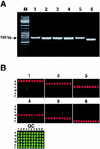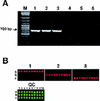Identification of Listeria species by microarray-based assay
- PMID: 12454178
- PMCID: PMC154633
- DOI: 10.1128/JCM.40.12.4720-4728.2002
Identification of Listeria species by microarray-based assay
Abstract
We have developed a rapid microarray-based assay for the reliable detection and discrimination of six species of the Listeria genus: L. monocytogenes, L. ivanovii, L. innocua, L. welshimeri, L. seeligeri, and L. grayi. The approach used in this study involves one-tube multiplex PCR amplification of six target bacterial virulence factor genes (iap, hly, inlB, plcA, plcB, and clpE), synthesis of fluorescently labeled single-stranded DNA, and hybridization to the multiple individual oligonucleotide probes specific for each Listeria species and immobilized on a glass surface. Results of the microarray analysis of 53 reference and clinical isolates of Listeria spp. demonstrated that this method allowed unambiguous identification of all six Listeria species based on sequence differences in the iap gene. Another virulence factor gene, hly, was used for detection and genotyping all L. monocytogenes, all L. ivanovii, and 8 of 11 L. seeligeri isolates. Other members of the genus Listeria and three L. seeligeri isolates did not contain the hly gene. There was complete agreement between the results of genotyping based on the hly and iap gene sequences. All L. monocytogenes isolates were found to be positive for the inlB, plcA, plcB, and clpE virulence genes specific only to this species. Our data on Listeria species analysis demonstrated that this microarray technique is a simple, rapid, and robust genotyping method that is also a potentially valuable tool for identification and characterization of bacterial pathogens in general.
Figures



Similar articles
-
Discovery of natural atypical nonhemolytic Listeria seeligeri isolates.Appl Environ Microbiol. 2006 Apr;72(4):2439-48. doi: 10.1128/AEM.72.4.2439-2448.2006. Appl Environ Microbiol. 2006. PMID: 16597942 Free PMC article.
-
Prevalence, identification by a DNA microarray-based assay of human and food isolates Listeria spp. from Tunisia.Pathol Biol (Paris). 2014 Feb;62(1):24-9. doi: 10.1016/j.patbio.2013.10.005. Epub 2014 Jan 23. Pathol Biol (Paris). 2014. PMID: 24461393
-
Evolutionary history of the genus Listeria and its virulence genes.Syst Appl Microbiol. 2005 Jan;28(1):1-18. doi: 10.1016/j.syapm.2004.09.005. Syst Appl Microbiol. 2005. PMID: 15709360
-
Genome organization and the evolution of the virulence gene locus in Listeria species.Int J Med Microbiol. 2000 May;290(2):167-74. doi: 10.1016/S1438-4221(00)80086-7. Int J Med Microbiol. 2000. PMID: 11045921 Review.
-
Comparative and functional genomics of Listeria spp.J Biotechnol. 2006 Oct 20;126(1):37-51. doi: 10.1016/j.jbiotec.2006.03.047. Epub 2006 Jun 6. J Biotechnol. 2006. PMID: 16757050 Review.
Cited by
-
Association between the Presence of Resistance Genes and Sanitiser Resistance of Listeria monocytogenes Isolates Recovered from Different Food-Processing Facilities.Microorganisms. 2023 Dec 15;11(12):2989. doi: 10.3390/microorganisms11122989. Microorganisms. 2023. PMID: 38138133 Free PMC article.
-
High density microarray analysis reveals new insights into genetic footprints of Listeria monocytogenes strains involved in listeriosis outbreaks.PLoS One. 2012;7(3):e32896. doi: 10.1371/journal.pone.0032896. Epub 2012 Mar 21. PLoS One. 2012. PMID: 22457724 Free PMC article.
-
Oligonucleotide chip for detection of Lamivudine-resistant hepatitis B virus.J Clin Microbiol. 2004 Sep;42(9):4181-8. doi: 10.1128/JCM.42.9.4181-4188.2004. J Clin Microbiol. 2004. PMID: 15365009 Free PMC article.
-
Discovery of natural atypical nonhemolytic Listeria seeligeri isolates.Appl Environ Microbiol. 2006 Apr;72(4):2439-48. doi: 10.1128/AEM.72.4.2439-2448.2006. Appl Environ Microbiol. 2006. PMID: 16597942 Free PMC article.
-
Identification of dermatophytes by an oligonucleotide array.J Clin Microbiol. 2007 Oct;45(10):3160-6. doi: 10.1128/JCM.00829-07. Epub 2007 Aug 8. J Clin Microbiol. 2007. PMID: 17687010 Free PMC article.
References
-
- Allerberger, F., M. Dierich, G. Petranyi, M. Lalic, and A. Bubert. 1997. Nonhemolytic strains of Listeria monocytogenes detected in milk products using VIDAS immunoassay kit. Zentralbl. Hyg. Umweltmed. 200:189-195. - PubMed
-
- Bansal, N. S., F. H. McDonell, A. Smith, G. Arnold, and G. F. Ibrahim. 1996. Multiplex PCR assay for the routine detection of Listeria in food. Int. J. Food Microbiol. 33:293-300. - PubMed
-
- Bind, J. L., C. Avoyne, and J. Delaval. 1996. Critical analysis of isolation, counting and identification methods of Listeria in food industry. Pathol. Biol. (Paris) 44:757-768. - PubMed
-
- Brunt, L. M., D. A. Portnoy, and E. R. Unanue. 1990. Presentation of Listeria monocytogenes to CD8+ T cells requires secretion of hemolysin and intracellular bacterial growth. J. Immunol. 145:3540-3546. - PubMed
Publication types
MeSH terms
Substances
LinkOut - more resources
Full Text Sources
Other Literature Sources
Research Materials
Miscellaneous

